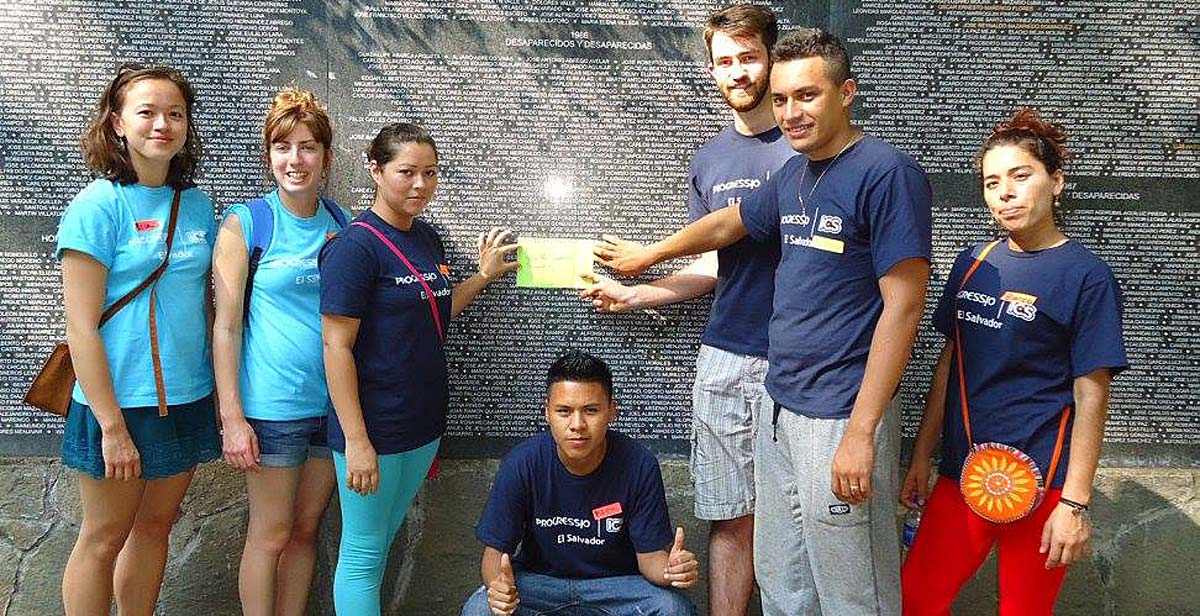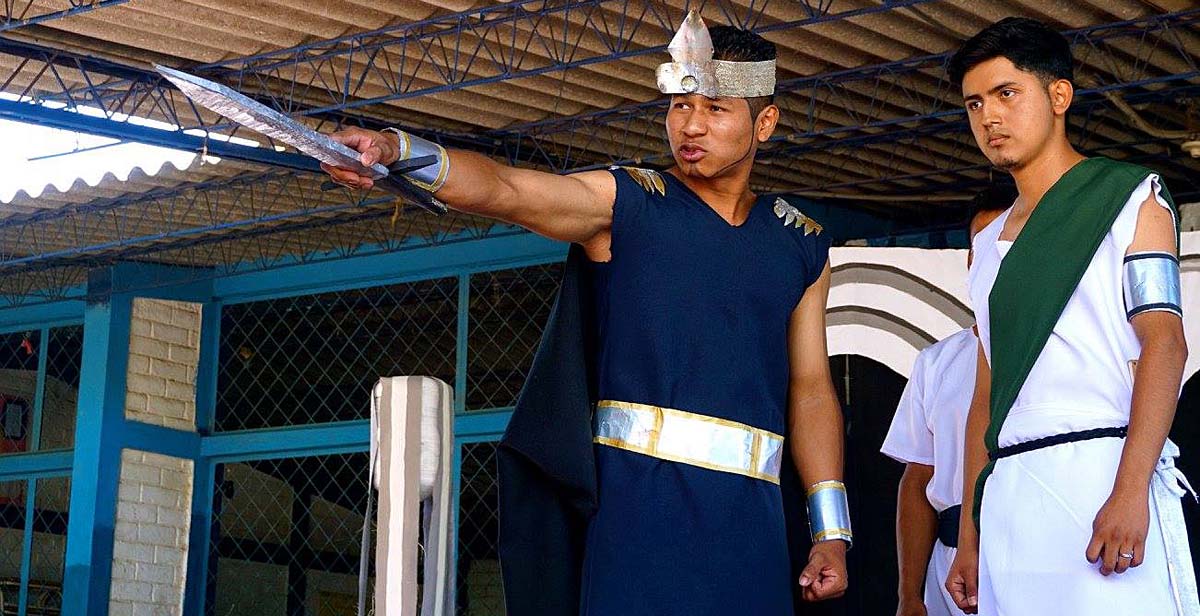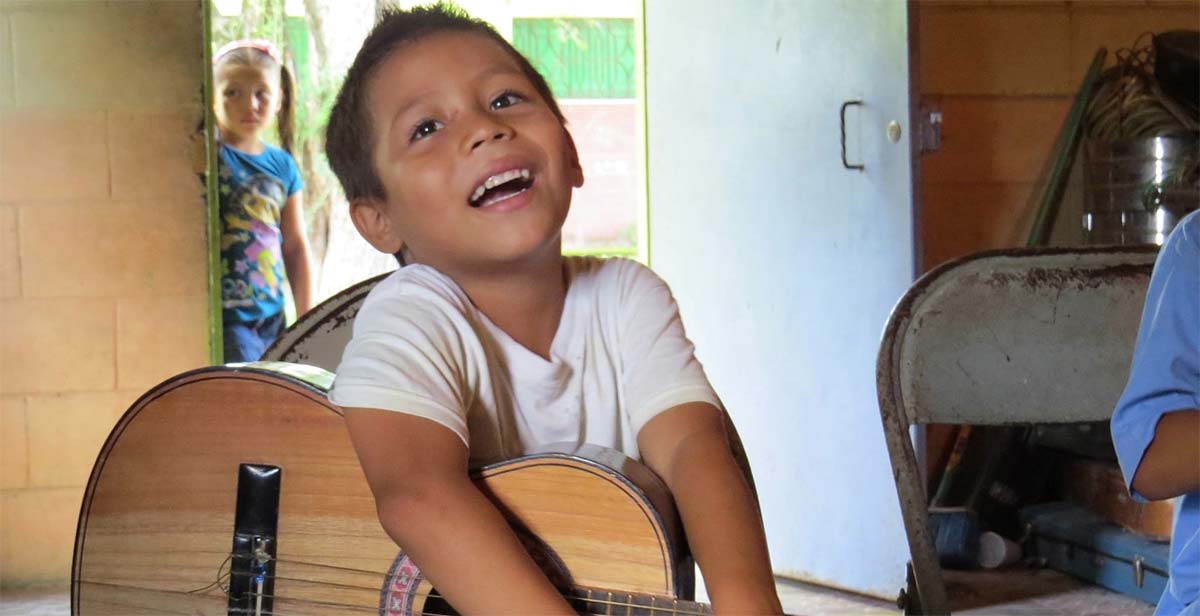“Music is something that helps you and pulls you out of all types of problems” – Ñoto, Bajo Lempa
Reflecting on the Consortium for Street Children’s International Day for Street Children that passed on 12 April, I’d like to take this opportunity to shed some light on the Salvadoran charity Music for Hope. Supported by the UK-based International Performer’s Aid Trust (IPAT) and the town council of Igualada in Catalonia, Music for Hope is an organisation that works with the most vulnerable of El Salvador’s young people to develop valuable social skills through teaching participatory music.
Formed by Birmingham musician Katherine Rogers on a visit to the Bajo Lempa in Southern El Salvador in 1996, where she began sharing her musical talents with disadvantaged young people, today Music for Hope has grown into a real force for youth empowerment in the region. This has only been made possible through international support from the likes of Spain and the UK. The charity draws its inspiration from the cultural heritage of the Bajo Lempa whose people, like many across El Salvador, harbour a tragic recent history of being oppressed and have managed to survive through an unwavering capacity for solidarity.
When Katherine first ventured to the Bajo Lempa with her guitar, El Salvador was still grieving after the end of their bloody civil war, which spanned from 1980 to 1992 and claimed the lives of some 80,000 Salvadorans and displaced a further one million. Then, the children who grew up in the turbulence of the conflict - known as ‘Children of War’ - who often suffered traumatic childhoods as refugees in Nicaragua or Honduras, carried this instability with them into the peacetime. Many children returned from displacement without the support of a family and found themselves living the life of a street child or simply were unable to express themselves in this new normality away from the war. At that time, Music for Hope provided an escape for many unstable young Salvadorans in the Bajo Lempa, where they could shelter for a time among friendliness and music and gain both social and practical skills that could eventually help them out of poverty.

However, before the grieving process after the brutality of the Salvadoran Civil War could be completed the country and young people in particular suffered another tragedy - the development of gang-to-gang violence on a massive scale in the noughties and escalation in the current decade. The crisis of gang violence in El Salvador, thought of as a hangover from the Civil War, emphasised by poor management of the peacetime by Salvadoran governments, has plunged the development of young people back into a state of stagnation. The expanding influence of gangs in El Salvador, particularly in the rural North and East, has not only meant diminishing opportunities for young people, which often drives them to illegal migration to the U.S., but also encourages the demonisation of youth from the country’s older generation.
Today, Music for Hope is addressing this sad problem of mistrust between old and young by holding performances to showcase the potential of youth when nurtured and not scapegoated for a complex problem. Ñoto, a previous student of Music for Hope, credited the project not only with giving him the “opportunity to explore another environment that was different to that of the street” and teaching him how to make genuine friends, but also how to let his guard down in front of adults. Ñoto speaks fondly of his teacher William, a Music for Hope volunteer, saying “he taught me to express myself in front of adults, in front of an audience - something I’d never done before.”
Through my International Citizen Service (ICS) placement with Progressio in western El Salvador, I came across the lack of trust between old and young, caused by the gang crisis, first-hand. The principal aim of our project was to empower young people and improve adults’ opinions of them in our host community. Despite the relatively well maintained status of Santa Catarina Masahuath, even there where the danger of gangs is not as severe as elsewhere in the country, young people were still kept at arm’s length by their elders. Our project attempted to tackle this isolated case in a similar yet smaller way to Music for Hope. Through ICS, Progressio were able to support the emerging youth group MIJUDEM to stage theatre entirely produced, acted and directed by young people to adults in the community. I am delighted to say that we made a real difference in Santa Catarina to raise the profile of youth, exposing to adults what young people could achieve with a little encouragement.

The challenge that Music for Hope face in the Bajo Lempa, however, is far greater than that which we faced. Gang recruitment and violence is far more of an issue there than in the West, so much so that Ñoto’s teacher William has despaired at the fact that promising young students of Music for Hope who have shown real signs of development often still end up ensnared by the ‘maras’ (gangs). William laments a lack of resources for the project that he feels would help them encourage students to stay away from the maras, to teach them the necessary social skills and awareness needed to avoid dangerous and compromising situations. Once a child has been pressured into recruitment into the maras they are part of the gang until their death. It is in every sense a life sentence. It is the aim of Music for Hope that, with continued and increased charitable funding from the public in countries such as Britain and Spain, they can purchase more instruments and train more music teachers. In turn this would enable them to move their lessons into local schools where they can reach huge numbers of young people in one sitting, with the aim of saving more and more young people from a kill-or-be-killed lifestyle. Music for Hope cannot do this without our continued support.
The story of Music for Hope is not all doom and gloom, however. Tony, another volunteer music tutor in the Bajo Lempa, has spoken about how encouraging it is to see alumni of the project developing support networks for the current crop of young music students. Tony spoke about his pride in those students in the music project who have been able to avoid the path of the gang member and are fantastic in building support networks for other students who are more susceptible to gang recruitment showing them that “music is a better option and that there are better things to do than be in a gang.” This support is especially valuable to those young people on the verge of recruitment; to have voices swaying them away from joining the maras when the influence of the gangs is so pervasive in day-to-day life in El Salvador is refreshing. Music for Hope can also boast that it is responsible for the origins and training of more than twenty active bands in the Bajo Lempa, some of whom have been able to tour and support national tours, some even producing records. The only sad thing is that Music for Hope does continue to lose some students to the gangs. With continued support, the project can hope to minimise these losses and proceed to instil confidence in disadvantaged young people and build and promote trust between adults and adolescents. Who knows, perhaps Music for Hope will soon be able to move their projects into schools and extend their influence beyond the Bajo Lempa and into other departments of El Salvador where young people are equally in need of this support.

If you would like to support or learn more about any of the projects and groups that I have mentioned above, then please take a look at the links below.
International Performers Aid Trust (IPAT)
Consortium for Street Children (CSC)
Mesa Integral de Juvenil (MIJUDEM)
Written by ICS Alumni Tom Edwards (October - December 2015 cycle)



